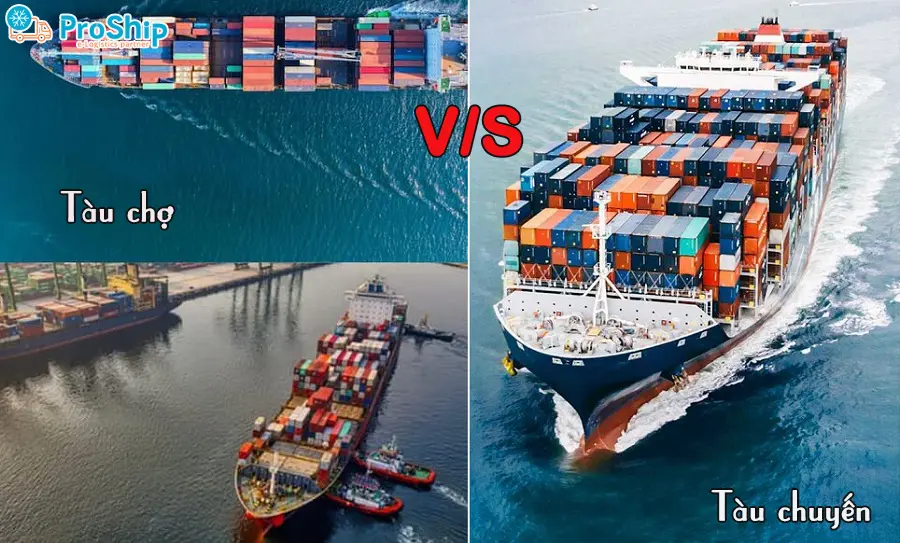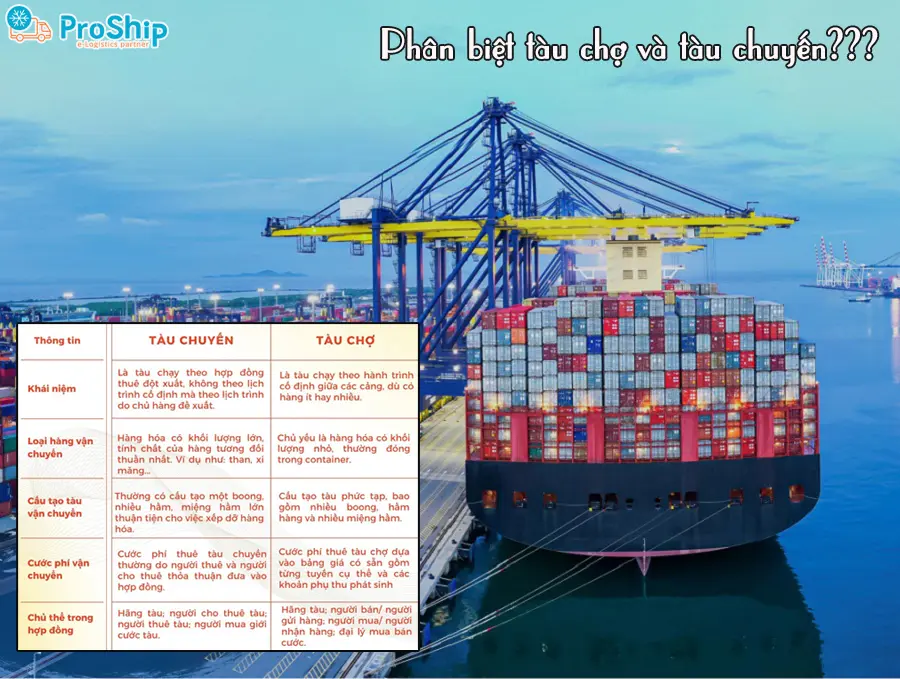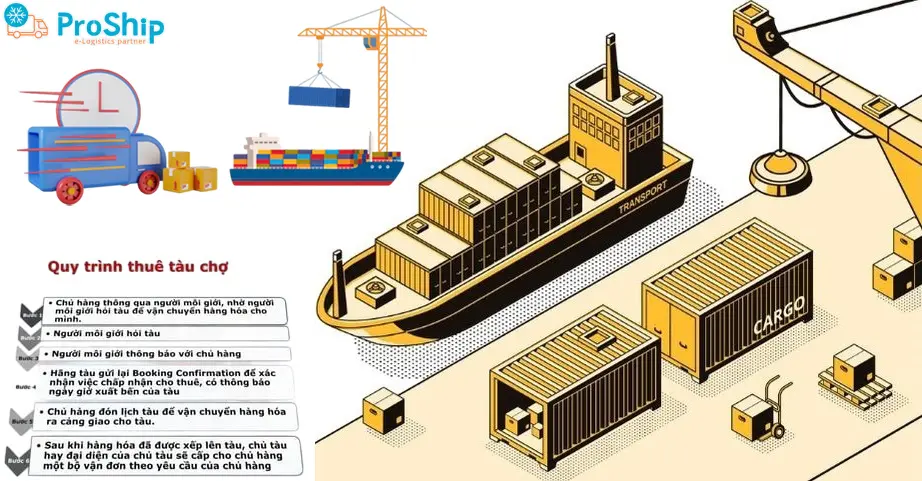x Business, private, ... need to transport FCL/LCL goods and want to know between market ships, trips different to choose the right needs?
X You want to find out whether the market ship and the ship is different?
x Import and export enterprises of sea goods have not grasped the process of renting trips and renting market trains?
Proship.vn we will update the information to know about the concept of renting market trains and trips. At the same time, businesses and shippers can easily distinguish between market ships and trips are similar, different as well as advantages and disadvantages of these two forms of renting ships.
The concept of renting a market ship and renting ships
Join Proship to find out how it is called renting a market and a train ship:
What is the rental of the Charter (Liner Charter)?
What is renting a market ship? Renting a market ship (or fixed route transportation) is a form of transport that the ship will follow a certain route and have a fixed schedule. The shipping lines providing this service are large shipping lines, operating on international sea routes.

What is renting a voyage charter?
What is renting a ship? Renting trips is to rent a whole ship to transport goods from the port to the port to the request of the tenant. The train has no fixed schedule and changes the flexible route (depending on needs).
The choice between renting a market ship and ships depends on:
- Budget;
- Goods;
- Schedule and flexibility.
Distinguish and evaluate the advantages and disadvantages of the market rental and renting ships
Proship helps you distinguish market trains and trips through the most objective assessments of the advantages and disadvantages of these two forms as follows:
Advantages and disadvantages of chartering trips
The form of renting trips has the following advantages and disadvantages:
Advantages when renting trips
- Cheaper ship rental rates than market ships (usually 30%cheaper);
- High flexibility: Can require unloading at any port and can change the port easily;
- The tenant is allowed to agree all the terms in the contract, not to be accepted as in the market rental method;
- The speed of transporting goods is fast because the rented vessel often runs straight from the port to the port to unload, few visit the ports along the way.
Disadvantages when renting trips
- The technique of renting ships, signing contracts is quite complicated because of the negotiation time.
- The fluctuating rates are often very strong and very strong, requiring tenants to master the market otherwise they will have to rent at expensive prices or unable to rent.
- In fact, people often rent trips to carry out cargo, large volumes such as coal, ores, cereals, ... or goods with sufficient quantities for the tonnage.

Advantages and disadvantages of market rental
The form of renting a market ship has the following advantages and disadvantages:
Advantages when renting a market ship
- The number of goods is unlimited;
- The calculation of delivery conditions in buying and selling easily, because the train follows the predetermined schedule;
- The unloading is usually undertaken by the ship owner, so it is simple to get procedures;
- Shippers will be proactive in saving charges;
- Convenient for goods owners in calculating business efficiency because based on the freight, it is possible to calculate the money first;
- The procedure for renting a simple fast train (can book train/internet).
Disadvantages when renting market ships
- Chartering charges on a unit of cargo is often higher than the charter charter: due to the cost of loading and unloading and because the market ship often does not take full advantage of the description (equivalent to 75%), it must be included running without goods;
- This method is not flexible in organizing transportation if the port is arranged or unloaded outside the prescribed journey of the ship;
- Legally legal charterers are often in the weak position because they are not free to agree on transportation conditions but must accept printed conditions in the bill of lading.
What is the difference between the bill of lading and the ship?
Join Proship to distinguish market ships and trips on the bill of lading according to the criteria:
| CRITERIA | Market bill of lading | Ship bill of lading |
| Feature | Issued for trains to follow the fixed schedule. | Issued based on a ship lease contract, not according to a fixed schedule. |
| Function | A voucher ownership | Mainly receiving receipts, not a document of goods. |
| Transfer | Can be transferred to third parties. | There is no ownership of ownership. |
| Transport terms | The terms are specified by the shipping company. | Terms of compliance with ship lease contracts. |
| Legality | Is the official document in commercial and financial transactions. | It is only a additional part for a ship lease and often clearly states "under the ship lease." |
| Cost of loading and unloading | Usually the shipping company is responsible. | Agreed by the parties in the ship lease contract. |
What is the process of renting markets and trips?
The process of steps to rent trips and renting market trains as follows:
The process of renting ships
The steps of renting trips are as follows:
- Search ships: Enterprises contact ship brokers or directly with ship owners to search for suitable trips;
- Negotiate and sign contracts: After selecting the appropriate ship, businesses negotiate contract terms including rates, schedules, responsibilities and obligations of the two parties;
- Preparation of goods: Goods are packed, labeled and prepared for transportation;
- Delivery at the port: Enterprises delivered goods to the port and carried out necessary customs procedures;
- Transportation: Ships will carry goods from the port to the port to schedule and the route is agreed upon;
- Delivery at the port destination: Goods are carried out customs procedures at the destination port and assigned to the final recipient.

Process of renting a market ship
The steps of renting market ships are as follows:
- Search for shipping lines: Enterprises contact the shipping lines providing fixed routing services to consider the schedule and transport capacity;
- Negotiate and sign contracts: After selecting the appropriate shipping company, the enterprise conducts negotiations of contract terms such as rates, shipping time, and accompanying services;
- Preparation of goods: Goods are packed, labeled and prepared for transportation;
- Delivery at the port: Enterprises delivered goods to the port to carry out customs procedures and delivery of goods;
- Transportation: Goods are transported to the destination port according to the fixed schedule;
- Delivery at the port destination: Goods are carried out customs procedures at the destination port and assigned to the final recipient.
Proship has helped you distinguish market trains and trips through each form of rental and disadvantages. Along with that is the process of renting Voyage Charter and renting a market charter (Liner Charter) that shippers and businesses wishing to transport goods by sea should know. Any questions related to cheap shipping services, contact 0909 344 247 .
